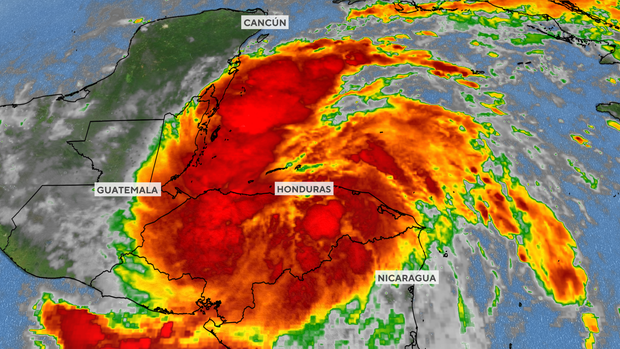Tropical Storm Sara batters Central America with torrential rains as forecasters warn of life-threatening flooding

Tropical Storm Sara hit Honduras’s northern Caribbean coast early Friday, dumping torrential rains in parts of Central America and southern Mexico after first falling overnight.
Sara made landfall about 105 miles west-northwest of Cabo Gracias a Dios on the Honduras-Nicaragua border, according to the US National Hurricane Center in Miami. That is close to Brus Laguna, a town of about 13,000 inhabitants. There are several other population centers nearby.
By dawn, the center said the storm was about 205 miles east-southeast of Belize City and moving west at 9 mph, with sustained winds of 50 mph.
A storm it was expected to stay in that path before moving back out to sea and threatening the coast of Belize.
CBS News
Sara is forecast to pass over or near the tourist resort of Roatan off the coast of Honduras on Sunday. Then this storm was expected to turn northwest towards Belize and the Yucatan Peninsula.
Mexican authorities have warned that “torrential rains” could result in the heavily populated Yucatan Peninsula.
Sara was forecast to drop 10 to 20 inches of rain, with up to 30 inches in isolated areas in northern Honduras. In an update at 7 a.m. Eastern, the hurricane center said “heavy rain, life-threatening flooding and mudslides” are possible over the weekend in Central America.
CBS News
Sarah – 18th called a storm of the 2024 Atlantic Hurricane Season – is expected to remain in the Caribbean over the weekend and slowly move into the Gulf of Mexico early next week. After that, its path is not clear. CBS News meteorologist Nikki Nolan said most of the models now tend to perish after entering the Gulf of Mexico or Mexico, but a few still have them heading toward Florida.
“Florida residents should closely monitor forecast updates as they come in,” Nolan advised.
Atlantic Hurricane Season it officially runs from June 1 to Nov. 30, with activity usually peaking between August and mid-October. The average season brings 14 named hurricanes, seven hurricanes, and three major hurricanes, according to the National Oceanic and Atmospheric Administration, which predicted the 2024 season will produce “above average” numbers.
Source link




